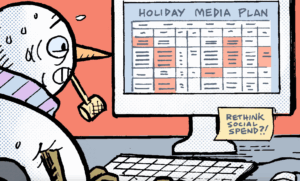 Facebook made solid progress on generating ad revenue, especially through growing use of its less than five-month-old Facebook Exchange and its aggressive focus on mobile advertising. At the same time, Facebook’s desire to spread itself and its products as widely and quickly as possible, particularly in developing countries, resulted in huge expenses — costs were up 82% during Q4 — that will probably continue to make its investors anxious.
Facebook made solid progress on generating ad revenue, especially through growing use of its less than five-month-old Facebook Exchange and its aggressive focus on mobile advertising. At the same time, Facebook’s desire to spread itself and its products as widely and quickly as possible, particularly in developing countries, resulted in huge expenses — costs were up 82% during Q4 — that will probably continue to make its investors anxious.
“On FBX, we’re very encouraged what we see in terms of marketer demand and ad performance,” said COO Sheryl Sandberg in her prepared remarks at the start of Facebook’s Q4 analyst call. “We see good data from clients and customers that it’s driving more conversions… The importance of FBX isn’t the product itself, but really what it represents. FBX is one way to make the ads more targeted. What you’re seeing from us is a really big push to make our ads higher-quality, better for users.” Read the earnings release.
Mark Zuckerberg began the Q4 analysts call with a continued emphasis on mobile, saying that 23% of the social network’s ad dollars now come from mobile. Meanwhile, Sandberg highlighted the connection between News Feed ads on both the PC and mobile as operating in tandem and leading to greater conversions.
Despite the importance of creating a more seamless and complementary experience across PC and mobile, Sandberg said there would be no information on when FBX would have a presence in its mobile ads business.
Overall ad revenue was up 41 percent, with Q4 the strongest of any other quarter, thanks to the expansion of News Feed ads, which drove eight times more conversions than the much despised marketplace ads that appear on the right side of users’ Facebook pages.
Among the new products is mobile App Install ads, which launched last fall. Twenty percent of the top-grossing iOS apps are using it, Sandberg said, adding that 2 million unique users claimed an offer through Facebook Offers. “We think the Facebook Offers product is well-placed to vie for media budgets,” she added.
Ad impressions were up slightly, but CPMs slipped by single digits. Sandberg attributed that to new introduction of so many new ad products and the expansion of these ads to developing countries. Zuckerberg hastened to add that there were positive pricing trends in western countries, as CPMs grew 18% in the U.S. and Canada.
At the same time, Sandberg downplayed the importance of clicks. “Of all the users who bought a product they saw advertised on Facebook, 99% of them didn’t click on the ad,” she said, noting that the company only began measuring conversions in December. “Expect us to do a lot more on measuring ad effectiveness, especially when it comes to mobile,” she added.
Facebook also fielded questions on its recently released Graph Search, which is still being rolled out, as a particular driver of ad spending and user engagement. “There’s not much I can share with you [on Graph Search],” Zuckerberg said. “It’s still early, it’s a completely new pillar of our ecosystem. But it will be a significant opportunity for us. It’s only been rolled to roughly tens or hundreds of thousands of people. We have data but not anything that’s really relevant at the moment.”
Zuckerberg indirectly addressed the possibilities and headaches associated with turning Instagram from a non-revenue producer to one that can offer the solution to creating brand-friendly mobile advertising.
“When it comes to our product design principles, we want the organic content to be of the same basic types of format as paid content,” Zuckerberg said. “Historically, advertisers want really big pictures and rich media — and we haven’t provided that yet. One of the things we started doing in the last year was the organic News Feed posts being moved to richer mediums. A lot of that comes from immersive experiences like Instagram. When you have those form factors for content, that gives you the ability to offer those form factors for advertisements well.”
In general, Zuckerberg sought to trumpet Facebook’s early ad moves, while at the same time, asking for patience in how quickly it can generate continued revenue growth, particularly from mobile. He was aided in that balancing act by Sandberg, who reminded the analysts that “Mobile gets 1% of ad revenue and 10% of time spent by consumers,” as a way of saying that the industry itself still has a lot of problems to solve when it comes to unlocking greater mobile marketing.













